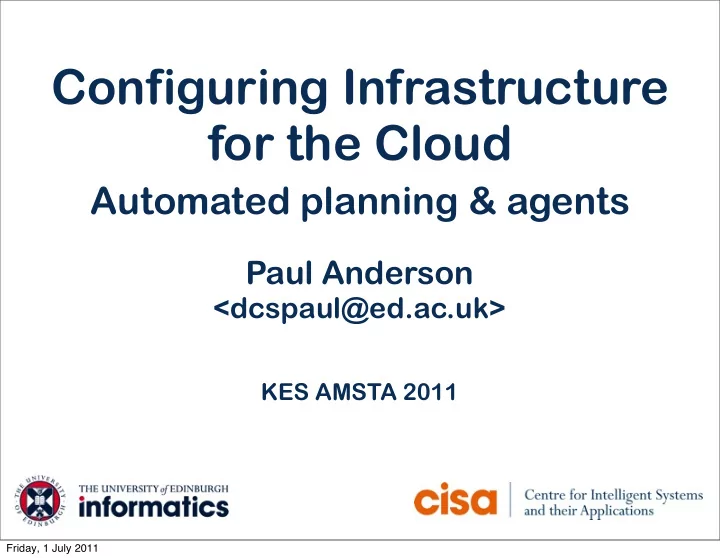

Configuring Infrastructure for the Cloud Automated planning & agents Paul Anderson <dcspaul@ed.ac.uk> KES AMSTA 2011 Friday, 1 July 2011
Background ◼ Several different communities have an interest in configuring some aspect of computing infrastructures - - “System configuration”, GRID, Network configuration, Application configuration ... ◼ Although the approaches have been slightly different, there is a lot of commonality - - Specification languages & policy, deployment, federated specification, security, robustness ... ◼ The Cloud is different only in emphasis .. - Less predictable, more devolved control, more opaque Friday, 1 July 2011
Configuration Evolution ◼ Manual configuration - doesn’t scale, error prone, ... ◼ Imperative scripts - scalable - but difficult to prove properties of resulting configuration ◼ Declarative specifications - guarantees properties of resulting configuration - but essentially “random” order of changes ◼ Stored change plans - declarative specifications & controlled change order - inflexible, unlikely to cover all requirements Friday, 1 July 2011
Change Planning Friday, 1 July 2011
An Example Reconfiguration A B A B (up) (down) (down) (up) C C “current” state “goal” state constraint: C is always aached to a server which is “up” Friday, 1 July 2011
Possible Plans 1. A down, B up, C.server=B ✘ 2. A down, C.server=B, B up ✘ 3. B up, A down, C.server=B ✘ 4. B up, C.server=B, A down ✔ 5. C.server=B, A down, B up ✘ 6. C.server=B, B up, A down ✘ Friday, 1 July 2011
“Cloudburst” firewall closed firewall open • Perhaps we need to change the DNS for the server ... • Maybe the server needs to access internal services ... Friday, 1 July 2011
Automated Planning ◼ Fixed plans cannot cover every eventuality ◼ We need to prove that any manual plans - always reach the desired goal state - preserve the necessary constraints during the workflow ◼ The environment is a constant state of flux - how can we be sure that the stored plans remain correct when the environment has changed? ◼ Automated planning solves these problems - but introduces others ... Friday, 1 July 2011
Herry’s Prototype ◼ Current state and goal state input to planner together with a database of possible actions ◼ Planner (LPG) creates workflow ◼ Plan implemented with “Controltier” & “Puppet” Friday, 1 July 2011
Some Issues ◼ Usability (most important!) - administrators are relinquishing control - automatic systems can often find “creative” but inappropriate solutions if some constraint is missing ◼ Plan repair - reconfigurations often occur in response to failures or overload, so the environment is unreliable ◼ Goals are often “soft” - there may be more than one acceptable goal state - usually with di ff erent levels of desirability - eg. “low execution time” or “least change” ◼ Centralised control has problems .... Friday, 1 July 2011
Decentralised Configuration Friday, 1 July 2011
Decentralised Configuration ◼ Centralised configuration - allows a global view with complete knowledge ◼ But ... - it is not scalable - it is not robust against communication failures - federated environments have no obvious centre - di ff erent security policies may apply to di ff erent subsystems ◼ The challenge ... - devolve control to an appropriately low level - but allow high-level policies to determine the behaviour Friday, 1 July 2011
GPrint (2003) PRINT CONTROLLER GLOBUS SmartFrog SERVER LCFG Daemon Print Print Manager Monitor Gprint OGSA Portal LCFG SLP print queue announcements SLP printer announcements PRINT SERVER Heartbeat SmartFrog LCFG Daemon Print LCFG lpd Server component Printer ◼ Distributed configuration with centralised policy ◼ Subsystem-specific mechanisms Friday, 1 July 2011
“OpenKnowledge” & LCC ◼ Agents execute “interaction models” ◼ Wrien in a “lightweight coordination calculus” (LCC) ◼ This provides a very general mechanism for doing distributed configuration ◼ Policy is determined by the interaction models themselves which can be managed and distributed from a central point of control ◼ The choice of interaction model and the decision to participate in a particular “role” remains with the individual peer - and hence, the management authority Friday, 1 July 2011
A Simple LCC Example a(buyer, B) :: ask(X) => a(shopkeeper, S) then price(X,P) <= a(shopkeeper, S) then buy(X,P) => a(shopkeeper, S) ← afford(X, P) then sold(X,P) <= a(shopkeeper, S) a(shopkeeper, S) :: ask(X) <= a(buyer, B) then price(X, P) => a(buyer, B) ← in_stock(X, P)then buy(X,P) <= a(buyer, B) then sold(X, P) => a(buyer, B) Friday, 1 July 2011
An Example: VM Allocation migrate IM IM IM IM role: role: underloaded overloaded Discovery service ◼ Policy 1 - power saving - pack VMs onto the minimum number of physical machines ◼ Policy 2 - agility - maintain an even loading across the physical machines Friday, 1 July 2011
Distributed Planning for Configuration Changes Friday, 1 July 2011
Behavioural Signatures Database Logic Presentation run run run stop stop stop ◼ Blue transitions are only enabled when the connected component is in the appropriate state - simple plans execute autonomously ◼ The plan executes in a distributed way ◼ The components are currently connected manually - and the behaviour needs to be proven correct in all cases Friday, 1 July 2011
Planning with BSigs (Herry’s current Phd work) ◼ If we have ... - a set of components whose behaviour is described by behavioural signatures - a “current” and a “goal” state ◼ We can use an automated planner to generate a network of components to execute a plan which will transition between the required states ◼ Some interesting possibilities - this can be structured hierarchically - the plans may not be fixed ie. they could handle some conditionals and errors Friday, 1 July 2011
Configuring Infrastructure for the Cloud Automated planning & agents ◼ Paul Anderson <dcspaul@ed.ac.uk> ◼ Herry <h.herry@sms.ed.ac.uk> Sponsored by HP Research Innovation Grant ◼ hp://homepages.inf.ed.ac.uk/dcspaul/publications/ kes2011-slides.pdf Friday, 1 July 2011
Recommend
More recommend